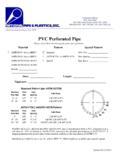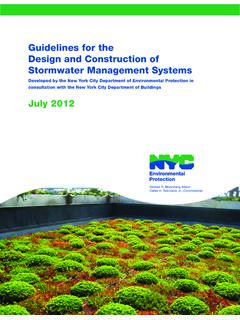Transcription of Wastewater Technology Fact Sheet: Wetlands: Subsurface Flow
1 United StatesEnvironmental ProtectionAgencyOffice of WaterWashington, 832-F-00-023 September 2000 WastewaterTechnology Fact SheetWetlands: Subsurface FlowDESCRIPTIONW etland systems are typically described in terms ofthe position of the water surface and/or the type ofvegetation grown. Most natural wetlands are freewater surface systems where the water surface isexposed to the atmosphere; these include bogs(primary vegetation mosses), swamps (primaryvegetation trees), and marshes (primary vegetationgrasses and emergent macrophytes).
2 A subsurfaceflow (SF) wetland is specifically designed for thetreatment or polishing of some type of wastewaterand are typically constructed as a bed or channelcontaining appropriate media. An example of a SFwetland is shown in Figure 1. Coarse rock, gravel,sand and other soils have all been used, but a gravelmedium is most common in the and medium is typically planted with the same typesof emergent vegetation present in marshes, and thewater surface is designed to remain below the topsurface of the medium.
3 The main advantages of thissubsurface water level are prevention of mosquitoesand odors, and elimination of the risk of publiccontact with the partially treated Wastewater . Incontrast, the water surface in natural marshes andfree water surface (FWS) constructed wetlands isexposed to the atmosphere with the attendant risk ofmosquitoes and public access. The water quality improvements in natural wetlandshad been observed by scientists and engineers formany years and this led to the development ofconstructed wetlands as an attempt to replicate thewater quality and the habitat benefits of the naturalwetland in a constructed ecosystem.
4 Physical,chemical, and biochemical reactions all contribute towater quality improvement in these wetlandsystems. The biological reactions are believed dueto the activity of microorganisms attached to theavailable submerged substrate surfaces. In the caseof FWS wetlands these substrates are thesubmerged portion of the living plants, the plantlitter, and the benthic soil layer. In SF wetlands theavailable submerged substrate includes the plantroots growing in the media, and the surfaces of themedia themselves.
5 Since the media surface area ina SF wetland can far exceed the available substratein a FWS wetland, the microbial reaction rates in aSF wetland can be higher than a FWS wetland formost contaminants. As a result, a SF wetland canbe smaller than the FWS type for the same flow rateand most effluent water quality design goals for SF constructed wetlands aretypically an exclusive commitment to treatmentfunctions because wildlife habitat and publicrecreational opportunities are more limited thanFWS wetlands.
6 The size of these systems rangesVegetationInlet ManifoldCold ClimatesOutletManifoldWaterSurfaceMembra ne Line orImpermeable SoilsTreatment Zone1/2 to 11/2 GravelOutlet Zone2 to 3 GravelInlet Zone2 to 3 GravelOptional InletManifold WarmClimatesSource: Adapted from drawing by Reed, 1 Subsurface FLOWWETLAND from small on-site units designed to treat septic tankeffluents to a liters per day (4 MGD) systemin Louisiana treating municipal Wastewater . Thereare approximately 100 systems in the treatingmunicipal Wastewater , with the majority of thesetreating less than m3/day (1 MGD).
7 Most ofthe municipal systems are preceded by facultative oraerated treatment ponds. There are approximately1,000 small scale on-site type systems in the waste waters from individual homes,schools, apartment complexes, commercialestablishments, parks, and other recreationalfacilities. The flow from these smaller systemsranges from a few hundred gallons per day to151,400 liters per day (40,000 gallons per day),with septic tanks being the dominant preliminarytreatment provided.
8 SF wetlands are not nowtypically selected for larger flow municipal higher cost of the rock or gravel media makesa large SF wetland uneconomical compared to aFWS wetland in spite of the smaller SF wetland arearequired. Cost comparisons have shown that at flowrates above 227,100 liters per day (60,000 gallonsper day) it will usually be cheaper to construct aFWS wetland system. However, there areexceptions where public access, mosquito, orwildlife issues justify selection of a SF wetland.
9 Onerecent example is a SF wetland designed to treat therunoff from the Edmonton Airport in Alberta,Canada. The snow melt runoff is contaminated withglycol de-icing fluid and a SF wetland treating1,264,190 liters per day (334,000 gallons per day)was selected to minimize habitat values and birdproblems adjacent to the airport runways. SF wetlands typically include one or more shallowbasins or channels with a barrier to prevent seepageto sensitive groundwaters. The type of barrier willdepend on local conditions.
10 In some casescompaction of the local soils will serve adequately,in other cases clay has been imported or plasticmembrane (PVC or HDPE) liners inlet and outlet structures are employedto insure uniform distribution and collection of theapplied Wastewater . A perforated manifold pipe ismost commonly used in the smaller systems. Thedepth of the media in these SF wetlands has rangedfrom to meters (1 to 3 feet) with meters(2 feet) being most common. The size of the mediain use in the ranges from fine gravel ( or in.)














